Wondering how alpaca shearing is done and what you should expect during your first shearing day? Let me walk through our 2020 shearing so you can get a good feel for the process, planning, and execution.
While everyone is falling in love with alpacas these days, alpacas are livestock animals and they have been specifically raised for their fiber. Alpacas are sheared each spring and this produces fiber (also called fleece or wool) that represents that year’s harvest.
This makes the shearing day a major event at any alpaca farm!
An adult alpaca weighing about 150 pounds will produce about 5-10 pounds of fiber that will be converted into yarn, clothing, or household items. The final destination of the fiber is determined by the micron count of the fleece. The lower the micron count, the higher the quality of fiber. A standard alpaca produces approximately 4 pounds of high-quality fiber (we call these firsts) and an equal amount of coarser fiber (we call these seconds and thirds).
While that all may seem simple enough, shearing an alpaca is not for the faint at heart. In our first year of shearing, I was totally unprepared, and I walked out of the barn to leave the task to my husband and son. I simply wasn’t aware of the process and it caught me off guard. By year two I was perfectly fine because I understood what was going to happen and how specific activities (like restaining the alpaca) were done for the health and wellbeing of the animal.
In the below video you’ll see Heartthrob being sheared. She is a cria and this is her first shearing. She transforms colors as the cria coat comes off, which was very cool to watch. Please note that the shearing team is not hurting her at all. She just new to shearing and the feel of the equipment.
Is Alpaca Shearing Cruel?
Alpaca shearing is not cruel, and it is done for the safety and welfare of the animal. I cannot stress that enough.
Organizations like PETA would love you to think alpaca shearing is cruel and wearing alpaca fiber is inhumane. I researched all of this before we purchased our first set of alpacas and I can tell you it’s just plain wrong. I’m what is called a “highly sensitive person” and as such I could never venture into alpaca farming if the claims of cruelty were true. It goes against everything within my heart and my soul.
Even as of May 2020, PETA released an article titled “Groundbreaking Undercover Investigation: Crying, Vomiting Alpacas Tied Down, Cut Up for Sweaters and Scarves” to show the stress alpacas goes through during shearing. However, this video does not represent the average alpaca farm and the handling of the average herds. This video by PETA was allegedly taken at a large farm in Peru that is owned by the Michell Group. While I cannot speak on the Michell Group’s specific handling on alpacas, I can speak about how we manage the shearing process.
I can also speak to the need for shearing. Alpacas do not shed their fur like a dog or cat. They must be sheared annually for their own health and welfare. Not shearing them is what is cruel because they can’t manage the summer heat. An alpaca who is not sheared regularly becomes matted and unmanageable. I’ve seen pictures on Facebook groups of rescued alpacas, and it is not a pretty sight.
I love our alpaca herd. I know them by name, I know their likes, and I know their dislikes. Many of my alpacas greet me at my arrival and seek pets and kisses. They do so because we treat them with respect, genuine love, and care.
My husband and I take great care in managing the shearing day and our herd as a whole. We hire professional shearers and we are with our herd the entire time that shearing is taking place. We know exactly what is done, why it is done, and we make sure nothing cruel ever occurs to the alpaca.
We also use shearers who do take even greater care with our pregnant girls and those who need special handling. We do so because we care for these animals and want to give them the love they give to us.
Why We Hire Professional Shearing Teams
Not only do alpacas need to be sheared, most farms hire professional shearing teams so they can guarantee their animals are moved through the process quickly and efficiently to reduce stress on the animal. And we farmers also stay close to assist the teams so we can increase the efficiency of the process. We do so because we truly care for the welfare of our livestock.
Here is why we opt for professional alpaca shearers (like TopKnot Shearing):
- Minimizes stress on the alpacas
- It’s a 3-4 person job that takes strength and dexterity
- While the alpacas are sheared, the team will also trim teeth and clip toenails
- The process requires specific equipment to help ensure the safety of the animal and human shearing
I don’t know about you, but I prefer to leave this process to professionals. That way I know my alpacas are being taken care of in the best possible manner.
It’s not cheap, but the money spent is well worth it for the alpacas and the alpaca farmers.
How to Get Ready for Shearing Day
On our first shearing day, we were pretty clueless. We didn’t know what to do to prepare. Who would? It’s not like alpaca shearing is standard practice for the average American.
My husband was on-task to figure it out and the farm where we purchased our first alpacas was where he found solid answers and direction. I’ve always been thankful to Stephan for the mentoring we received those first few months of owning alpacas and shearing day was just another example of this gratitude.
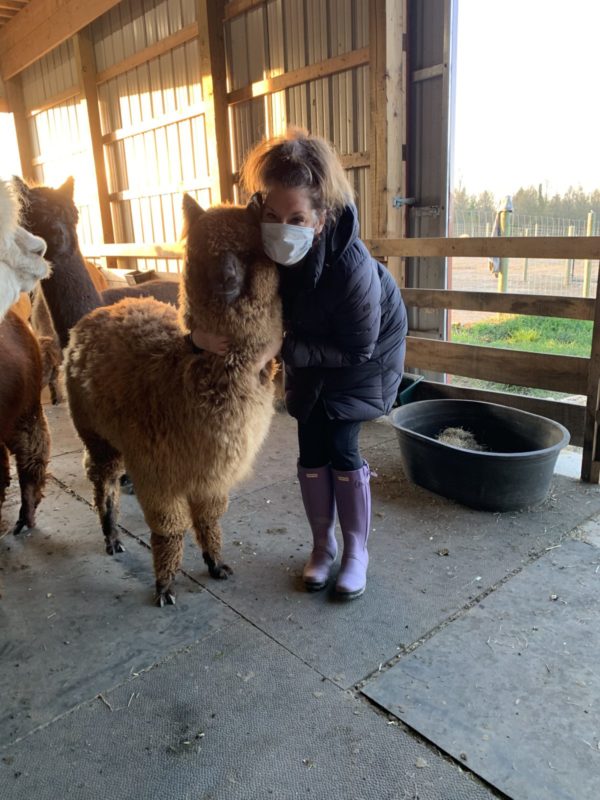
What we did learn, was invaluable. It boils down to a few steps to make the entire process go faster and a lot smoother for everyone involved:
- Keep the alpacas as dry as possible, even if you need to lock them in the barn to do so.
- Remove any straw you have on the barn floor. This makes cleaning the fiber much easier.
- Vacuum or blow out the fiber the day before shearing. The more vegetation you remove, the less “stuff” that will interfere with the shearing process and get stuck in your fiber during processing.
- Pen the alpaca up for less stress and drama. By keeping them in a smaller space, you’ll be able to quickly move them through the shearing process. This will be less drama for you and much less stress on the alpacas.
- Buy three clear trash bags for each alpaca.
- Prepare three labels for each alpaca and mark them with the alpacas’ name, year, and a 1, 2, or 3.
- Higher-end alpacas may also require you to “noodle” the fiber blanket, so research this further if you want to have special samplings and testing done on show alpacas.
- If you have higher quality alpacas, have one small Ziplock bag ready to collect samples for fiber testing. You’ll want these marked with the alpacas’ name and ready to go.
- Have any immunizations and deworming shots prepped and labeled.
- Prepare a list of alpacas with special notes for you and the shearers. We had lots of pregnant ladies and one female has a jaw issue. We needed this information front and center so the shearers knew what to watch out for and who to be extra careful with while removing the fiber.

In addition to that above list, I also tried and make sure we had a buddy system in place. Heartthrob and Onyx are best buddies, so I asked that they go right after each other. The same was true for Bean and Zula. That way they could stay with their buddy as they waited and then be with their buddy right after shearing was finished.

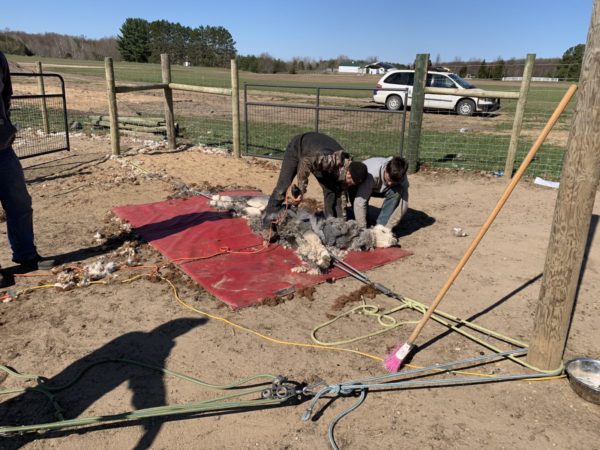
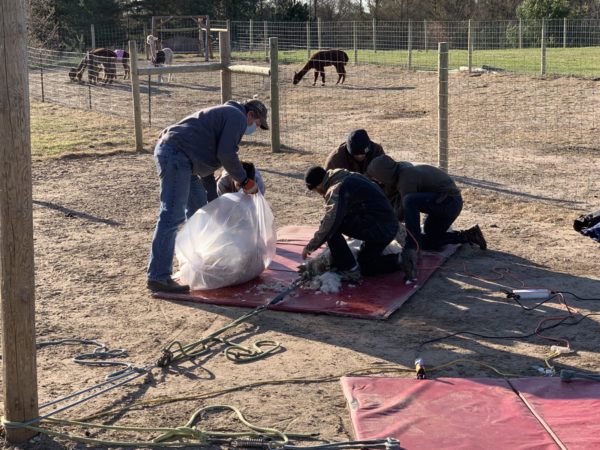
We had a large area waiting for them after the shearing so the alpacas could spread out, drink some water, and just relax. If it is a nice day, this will result in many alpacas sunbathing in their new skinny and fiber-free bodies.
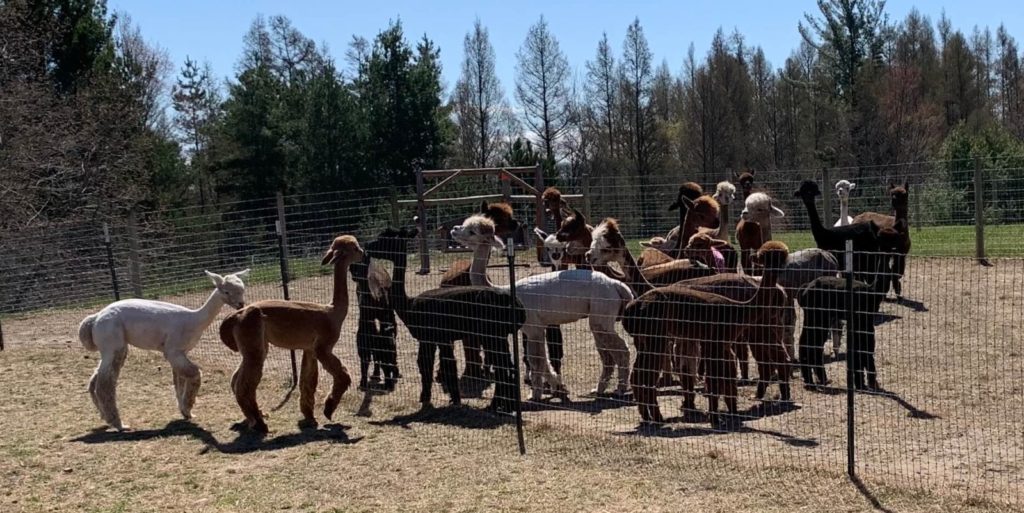
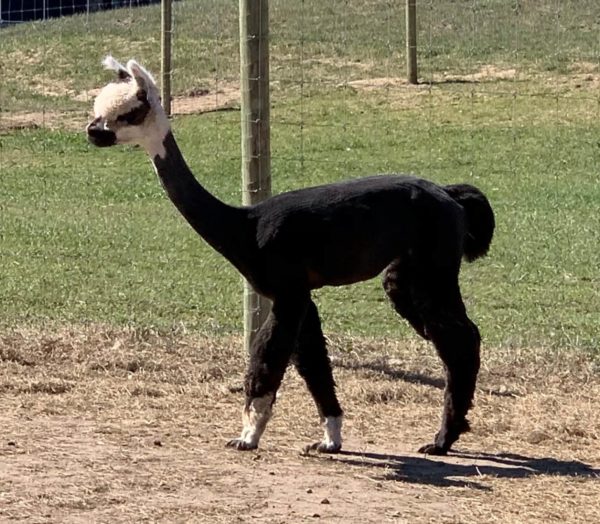
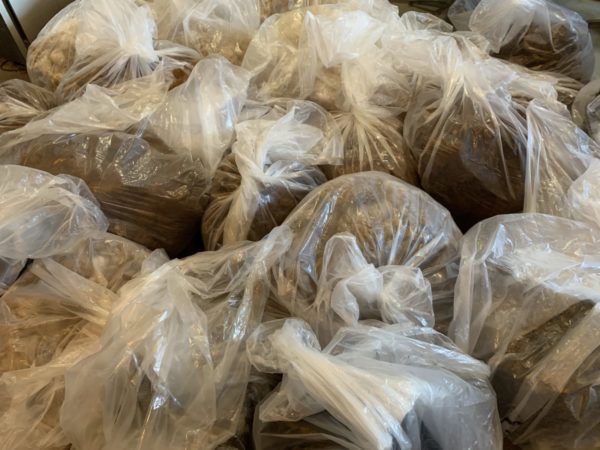
Why Alpaca Fiber is So Valuable
At this point, you might be wondering why there is all this fuss about the alpaca fiber. And you would be correct in questioning this process. We tend to treat the alpaca fiber like it is gold because it is the harvest of the farm.
Alpaca fiber doesn’t have the full demand it should in the United States and this is because most Americans are unaware of the value it offers. But I’m hoping the world’s newfound love of alpacas and llamas will help more Americans see the value of this wonderful wool.
Here is what makes alpaca fiber so darn special and expensive:
- It’s hypoallergenic, so people like me who are allergic to traditional wool, can wear it. Alpaca fiber doesn’t have the same lanolin, which is what I’m allergic to. I can wear sheep wool for three minutes before I start to develop a rash, yet I can easily wear alpaca clothing all winter long.
- Alpaca fiber is extremely warm, and honestly, warmer than traditional wool.
- Alpaca fiber is super soft with a very high comfort factor, so it makes an excellent option for clothing. Our industry pays close attention to this measurement and the highest-ranked and priced alpacas will come with the highest marks for the comfort factor.
- Alpaca fiber naturally repels water.
- Alpaca fiber is naturally fire resistant.
- Alpaca is ecofriendly in the best sense. Alpacas are soft on the earth and they require limited food intake, so they truly are a sustainable fiber producer.
What to Do With Your Alpaca Fiber
Alpaca fiber is also very versatile and this only adds to the growing worldwide demand for it.
When the fiber is removed from the alpaca, it is divided into three groups:
- The first group is called prime or firsts. This is the highest quality of fiber and it comes from the alpaca back and sides.
- The second group is called seconds. It comes from the chest, neck, and belly.
- The thirds (last group) is the legs and feet. It’s also the dirtiest and roughest of the fiber.
Each group of fiber has a purpose and can be used in a variety of things:
- Prime blanket – Yarn (Fingering, Sport, DK, Worsted, etc.), hats, scarves, socks, throws, and pillows
- Seconds and thirds – Dryer balls, felting, rugs, animal beds, cat toys, nesting balls for birds, etc.
Options for processing your alpaca fiber:
- Fiber Co-ops – You send in your fiber and you receive money or credits to buy finished products.
- Micro Mills – These are small local mills that will make yarn, batting, roving, and felt.
- Large Mills – These mills will make yarn, yarn blends, or finished goods.
- Facebook 50/50 Groups – You send your yarn to a crafter who will hand process it into yarn. They keep 50% of it and send the other 50% of it back to you.
- Hand Processing – This would require you to process the fiber through skirting, washing, picking, carding, and spinning.
Don’t worry if you are not crafty and that last item doesn’t appeal to you. I’m not crafty and wouldn’t have any clue about creating my own yarn or knitting socks. I have my fiber processed into yarn at professional mills and then I recruit knitters to whip me up something amazing. You’ll find some handmade items in our online alpaca store from my Aunt Diane and my mother-in-law Lil. They both possess all the crafting talent that was skipped over me.
Extra Things to Know
A few final points you should know about shearing if you are a new of future alpaca farm in the United States:
- There are few shearing teams in the United States, so make sure you research and ask for referrals to get you headed in the right direction.
- It’s hard to get on the schedules, so plan ahead and book your shearing months in advance.
- The wind was difficult to work with, so select a location indoors if at all possible. We didn’t realize the wind was going to be that strong (see above video) or we would have made other arrangements.
- Biosecurity is super important, so select a shearing team that adheres to quality standards and best practices for cleaning clothing, boots, and equipment between farms.
- The cost of shearing is about $30-50/alpaca plus a $100 set up fee. Budget for this, because it is a non-negotiable item in any farm business plan.
- You’ll also need to have cash on hand to tip the shearing team. The tip would scale in size along with your herd size and the amount of time they spent on your farm.
- The shearing teams work long hours so feed them. I baked our team a lasagna this year and sent it with them.
Finally, I’d tell you to stay calm and relaxed. The more relaxed you are, the more secure your alpacas will feel.
While the alpacas hate the shearing itself, they feel fabulous once done and they roll around happily in the grass. When they are done rolling, they take naps in the sun. So expect a few sprawled out alpacas sunbathing in the grass.

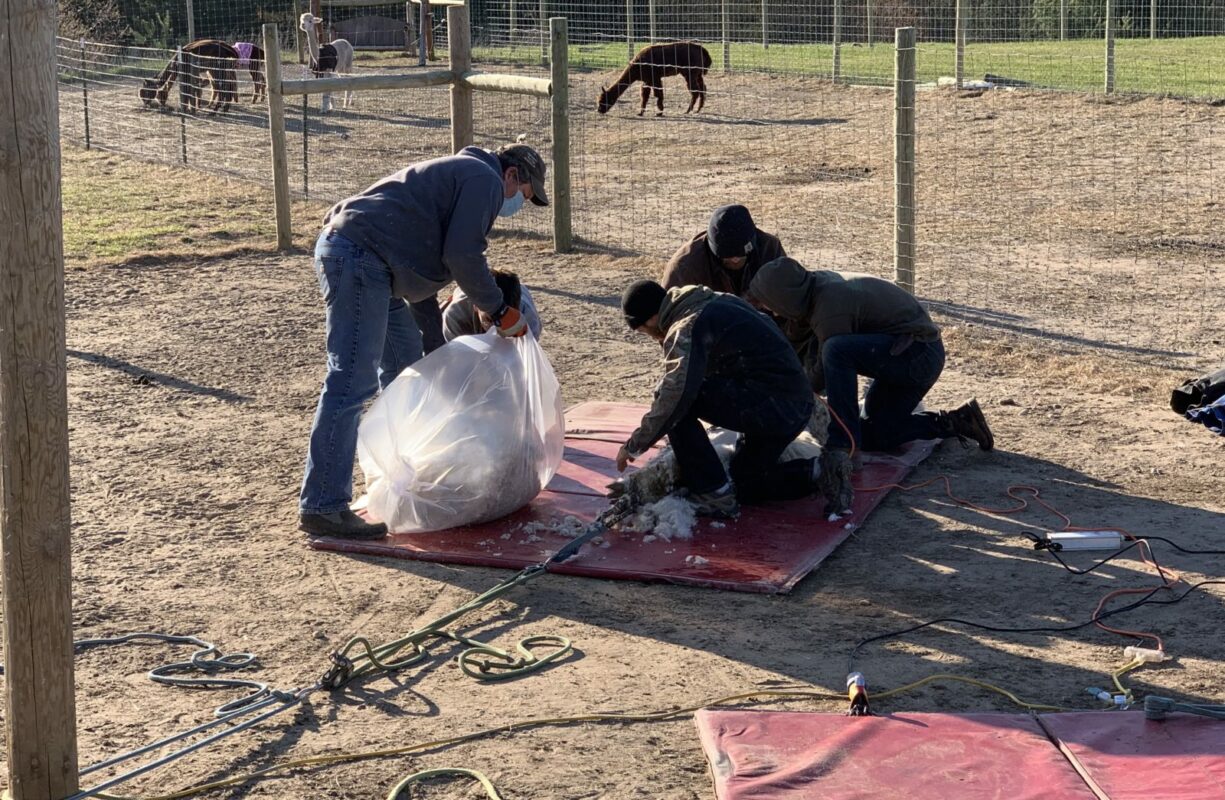

We just saw video footage from PETA and it was disturbing. We saw the animals vomiting and being manhandled. This is TOTALLY unacceptable. What are YOU doing to safeguard the alpacas on your farm? Man’s cruelty is BEYOND belief.
Liza if you read the post above, you would see I mention the PETA video and I specifically talk about our direct interaction to ensure our alpacas are sheared safely and in a loving manner.
My husband, son, and I are very involved in the shearing process. Not only do I personally tell the team which alpacas to shear next (so they can stay with their buddies), I stand right next to the alpaca during shearing to provide emotional support and so I know they are well cared for. Then once done, I move towards the open pasture and water, so my alpaca knows where to go to get a drink and run free with their barn mates.
I love my alpaca more than I can express in a post comment. They are family to me and I would never let them be treated poorly.
We hire professionals so the shearing process can be efficient, well done, and so we can minimize the impact it has on our alpacas. Our alpacas are not traumatized by the event. Instead, they feel naked and free and immediately start jumping around and rolling on the ground in happiness.
You’ll find the majority of the alpaca owners in the United States feel like I do and we take great care in making sure our alpacas are sheared in a responsible and caring manner.
Rebecca, great article!
We’ve had alpacas since 2003. Our largest herd was 35. We are down to 12 and one llama. We are no longer breeding…letting them retire along with us!!
Your info and suggestions are PERFECT!
I appreciate your care!
When I looked into what Peta and other animal friendly sources said about wool, they used alpaca as one of the friendlier versions. They specified that there were also humane wools that weren’t alpaca, and specified the process instead of all wool practices. It is a misunderstanding from those who saw or read something, or heard it second hand, and then spread that information. It was well intended, and stated to support those who process wool humanely, but it seems as if that has also been misunderstood. It was said in a way that tried to lead people to sources like yours instead of against it, but somehow some wires got crossed. Sorry you got the short end of it! Not all organizations that care about animals are misinformed, nor are all the people who follow, so I hope you’ll consider that in future comments. I could care less if you insult somebody who deserves it, which could easily be Peta, but there are a lot of good people that are behind them, and also other organizations that are concerned about animal welfare.
Good luck with your business and all else!
I read your story and it is heartwarming. They look like lovely animals and you obviously love them. Alpacas have to be sheared much like grooming a dog. Not doing it is more cruel as long as it’s done properly. Looking into alpacas myself!!! Enjoyed the stories and the info.
Kristen you will not regret entering into an alpaca journey. I start my day drinking coffee with them and I end my night checking on everyone before bed. They truly have captured my heart and I’m sure they will do the same to you!
I don’t farm anything but I loved your shearing day story! It was very informative and the alpacas look so cute lol with their little legs 🙂 reminds me of my dog after his grooming appointment, the rolling around in the grass. Thanks for sharing the info and your love for those cute animals!
Hi. Where can I go to get certified . I want to learn and do this every year.
Maria, I do not know the answer to that question. I’m not even sure if certification exists. I would recommend you reach out to a few shearers to see if they know of training sources.
Hi maria,
my name is chris and I am a shearer since 07′ in WA. I ended up going to an alpaca outdoor show and saw this and was interested. Talked to the shearer and he recommended taking a week of sheep shearing school. Then he took me as a partner for a week. Been doing this since and just last weekend finished my season. Best of luck to you
I have only one alpaca and she really needs to be shorn. I lost my husband some time ago and didn’t pay enough attention because to my alpaca, only to feed and water her daily, so some things got behind. I know it is late in the season and I live about five miles from Cotati, but I really need help please contact me by calling (707)753-1253 and leave a message. My email is [email protected]..my name is Marye.
Marye we are not familiar with shearers in California, since we’re in Michigan. I would ask this question in the California Alpaca Association Group on Facebook (https://www.facebook.com/groups/Calpaca/about) or reach out to the association (http://www.calpaca.org/) directly.
If your alpaca hasn’t been sheared for years, you will have to take great care in shearing. You don’t want to shock their system.
But that said, the alpaca has to be sheared. It is a life and death matter for alpacas, and this is even more critical in hot climates like California.
I needed to replace an Alpaca blanket that I borrowed from a friend. and I have been putting it off because I could not order something that would injure or kill an animal. Thanky you so much for this presentation that has taught me to seek the other side of the story. I will order her replacement blanket now with a happy purchase. Thanks again Pat White, Colorado
What is the typical cost of an alpaca, cost per year for feed/care, and how many would you suggest as a “starter” herd? Thank you!
Tonya the cost of a starter herd will really depend on the intended usage and sex purchased. Show, fiber, and pet level alpacas will all have significant variances in costing. I do cover this in another post at https://cottoncreekfarms.com/alpaca-cost-and-care/. You’ll also find estimates on annual cost of maintenance in this article.
Do you send the sick or elderly alpacas to the slaughterhouse.
Do you care for them in retirement until old age and provide complete and comprehensive veterinary care?
We do not process alpacas for meat, nor do we send retired alpacas elsewhere. We have a 20-year-old alpaca that we adopted at age 17 because her owner died. We have a rescued llama named Lucy who we’ve adopted because she needed a home. And we have multiple girls who are retired and living out life on our farm. They are family and we treat them as such.